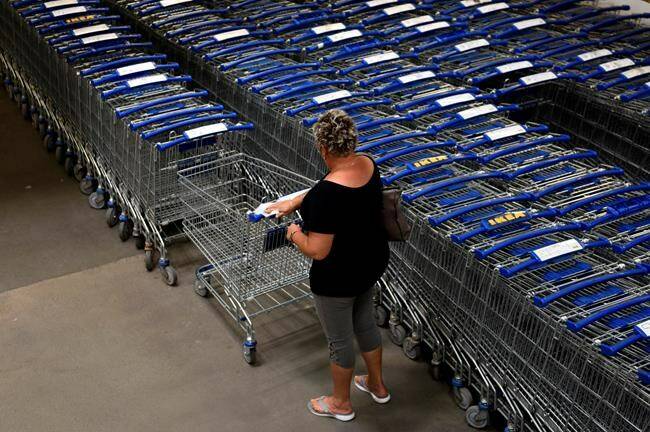The heavy cost of light fingers
Advertisement
Read this article for free:
or
Already have an account? Log in here »
To continue reading, please subscribe:
Monthly Digital Subscription
$0 for the first 4 weeks*
- Enjoy unlimited reading on winnipegfreepress.com
- Read the E-Edition, our digital replica newspaper
- Access News Break, our award-winning app
- Play interactive puzzles
*No charge for 4 weeks then price increases to the regular rate of $19.00 plus GST every four weeks. Offer available to new and qualified returning subscribers only. Cancel any time.
Monthly Digital Subscription
$4.75/week*
- Enjoy unlimited reading on winnipegfreepress.com
- Read the E-Edition, our digital replica newspaper
- Access News Break, our award-winning app
- Play interactive puzzles
*Billed as $19 plus GST every four weeks. Cancel any time.
To continue reading, please subscribe:
Add Free Press access to your Brandon Sun subscription for only an additional
$1 for the first 4 weeks*
*Your next subscription payment will increase by $1.00 and you will be charged $16.99 plus GST for four weeks. After four weeks, your payment will increase to $23.99 plus GST every four weeks.
Read unlimited articles for free today:
or
Already have an account? Log in here »
Hey there, time traveller!
This article was published 11/07/2023 (880 days ago), so information in it may no longer be current.
The distribution of the new federal grocery rebate, which aims to help Canadians cope with rising food costs, began July 5. Long before the cheques were mailed, however, many Canadians were resorting to a five-finger rebate — shoplifting — as an illegal way of adjusting to higher prices at supermarkets.
Shoplifting is no longer the preserve of an individual surreptitiously sneaking an item and slipping out the door.
Some thieves fill up shopping carts full of thousands of dollars of goods and use it as a battering ram against staff or security guards who try to foil the robberies by blocking the exits, as shown by one incident at a Giant Tiger outlet in Winnipeg in May that was filmed on a shopper’s phone camera.

FileS
All shoppers pay for shoplifting.
Organized shoplifting is also on the rise — some thieves case stores for long periods seeking out blind spots in a supermarket’s surveillance cameras, mirrors and the eyes of employees — before picking the right time to pounce and flee with high-end items to be sold on the black market or online.
Large retail chains, such as those that dominate Canada’s groceries sector, have added security guards, closed secondary exits and have set up barriers that block the remaining exit to prevent grab-and-go thieves.
Some items for sale have to be kept under lock and key, such as over-the-counter medications, razor blades and infant formula, which can frustrate paying customers as much as potential shoplifters.
Supermarkets aren’t the only targets of potential thieves either.
A Winnipeg Police Service investigation dubbed Project Falcon, which aims to address retail theft in the city, led to the arrest of man June 28 who has been accused of walking out of a CF Polo Park electronics store with 35 pairs of headphones worth $440 each without paying on 12 different occasions.
Manitoba Liquor Marts outlets in Winnipeg had to resort to elaborate security measures to prevent thefts after several violent incidents in 2019 that left employees needing medical care.
Entrances are blocked to customers until they provide valid identification, which are scanned by security guards or staff. The practice has led to longer lineups, but a drastic downturn in crime.
Cynics who complain about “greedflation” by grocery giants might also say preventing shoplifting is the cost of doing business. They would fail to realize it’s consumers who wind up paying for these modifications with higher prices.
Nor would they realize the damage shoplifting does to a small business, the margins for which are already razor-thin and which likely don’t have the money to pay for extra security guards or to renovate their store’s doors to deter thieves the way many supermarkets have done.
While the Retail Council of Canada says the country’s businesses loses billions of dollars to theft annually, Juan More Thing co-owner Terry Neplyk, whose Grand Marais emporium that has faced “ridiculous” displays of shoplifting, describes the cost in more relatable terms and puts a face and name to a widespread problem that plagues the country.
“Every time something’s stolen, somebody steals something for $100, you have to do $1,000 worth of business to make up that $100 that’s been stolen,” he told the Free Press. “It’s very, very rough on being a small-business owner to be able to stay profitable when people do steal, and we know it’s happening on a regular basis.”
If Canada’s businesses, large and small, are to remain open and provide a safe and pleasant shopping experience, consumers will have to recognize that shoplifting is society’s problem that must be addressed, and not be passed off as a regular business expense.


